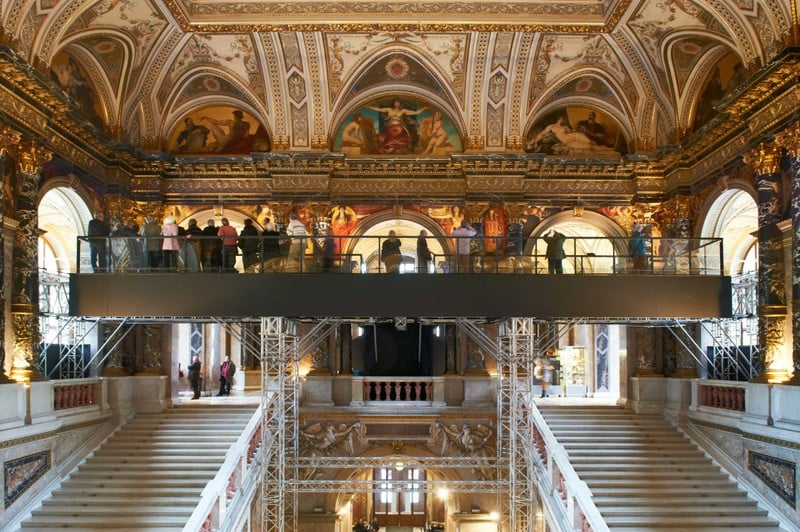
In 1918, as World War I drew to a close, Europe lost four titans of Viennese Modernism: the artists Gustav Klimt, Egon Schiele, and Koloman Moser and the architect Otto Wagner. In honor of the centenary of their deaths, the Vienna Tourism Board is planning a massive citywide initiative, “Beauty and the Abyss,” a series of exhibitions highlighting the impact of these four artists, and a celebration of turn-of-the-century Wiener Moderne, or Viennese Modernism.
“Those four men were ahead of their time, very modern and forward thinking, and unafraid to break taboos,” Helena Hartlauer, a spokesperson for the Vienna Tourist Board, told artnet News. “Celebrating that legacy is a perfect opportunity for the city to showcase that era and its continued influence today.”
Of the four men being honored in Vienna, Klimt may be the most well known, a figure beloved for his erotic portraits of women, the most famous of which are lavishly embellished with gold leaf. His protégé, Schiele, was even more sexually explicit in his depictions of women—so much so that advertisements for “Beauty and the Abyss” featuring his contorted nudes were censored in Germany and the UK.
The first major exhibition dedicated to Wagner in 50 years will open at the the Wien Museum Karlsplatz in March, while Moser—a prolific painter, graphic designer, and craftsman—will get his due in an exhibition at MAK, the Austrian Museum of Applied Arts, home to the archives of the Wiener Werkstätte, an art and design community founded by Moser and Josef Hoffmann in 1903 on the principle of the Gesamtkunstwerk, or total work of art.
Beyond the four featured figures, “Beauty and the Abyss” takes a deeper dive into the broader cultural movement, looking at the social conditions that allowed modernist art to flourish in fin-de-siècle Vienna: the artistic communities at coffee houses and salons, and the network of collectors supporting the arts, among other factors.
The tourism board started planning the event in early 2016, and thought carefully about what to call it. “Viennese Modernism is different than classical art or Art Nouveau,” said Hartlauer. “It’s not about being only decorative and colorful and pleasant. There’s very often a dark element combined with the beauty.”
Joseph Maria Olbrich (left), artists Franz Hohenberger, Koloman Moser and Gustav Klimt (right) in Fritz Waerndorfer’s garden in Vienna (1899). Photo courtesy of the Viennese Tourism Board. © IMAGNO/ÖNB.
The Österreichische Galerie Belvedere will hold two exhibitions related to the theme. “Klimt Is Not the End: Awakening in Central Europe” considers the deaths of Klimt, Schiele, Wagner, and Moser not as the closing of an artistic era but as a turning point in the development of Modern art in the former Austro-Hungarian Empire. It features work by the likes of Oskar Kokoschka and Albin Egger-Lienz.
The museum will also spotlight its Schiele collection in “Egon Schiele: Ways of a Collection,” pairing the artist’s paintings with preliminary sketches or related works.
For his part, Klimt will take center stage at the Kunsthistorisches Museum Wien, home to his Nuda Veritas, with “Stairway to Klimt,” in which a raised platform extends nearly 40 feet above the grand staircase, offering visitors up-close access to a cycle of 13 Klimt paintings on the upper walls.
“Normally, you simply you just walk by it and you don’t realize what a hidden gem that you have in the staircase,” said Hartlauer. (The museum previously installed the “Klimt bridge” with in 2012, on the occasion of Klimt’s 150th birthday.)
Secession, a contemporary art exhibition space founded by Klimt and a group of artists, including Moser in 1897, will present “Gustav Klimt, Koloman Moser and the Art of their Time.” Home to Klimt’s monumental Beethoven Frieze mural cycle (1902), the institution will delve into its early history and feature a recreation of Wreath Bearers, a plaster frieze by Moser of a row of dancing girls that was once a key feature of the building’s architecture.
The Jewish Museum Vienna and Ernst Fuchs Museum in the Otto Wagner Villa will both revisit the turn-of-the-century Viennese salon, where cultural and political discourse thrived, in the respective exhibitions “Arnstein, Todesco, Zuckerkandl: Hostesses and Their Salons Between Art and Politics” and “Old Viennese Salon Culture: Dazzling Stage for a Society.”
Other participating institutions include the Museum of Sound, Gustav Klimt’s Studio, the Arnold Schönberg Center, the Hofmobiliendepot Imperial Furniture Collection, the Literature Museum of the Austrian National Library, House of Museum the Museum of Sound, the Bulgarian Cultural Institute Wittgenstein House, and the Austrian Friedrich and Lillian Kiesler private foundation.
See more works that will be on view across the city below.
UPDATE: Due to delays in renovations, the Secession has cancelled their planned “Beauty and the Abyss” exhibition, “Gustav Klimt, Koloman Moser and the Art of their Time.”